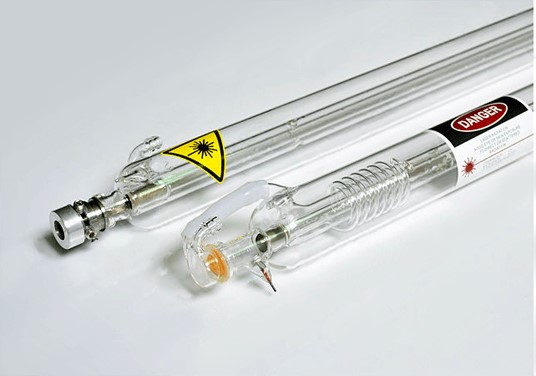There are major differences between DC glass lasers and RF metal lasers that should be considered when selecting a laser system. These are described below.
DC Glass Lasers
The first CO2 lasers invented in the early 1960s were DC glass lasers. DC laser technology has not advanced since the 1960s primarily due to a shift in laser technology development to radio frequency and all metal laser design.
A DC glass laser consists of a long, fragile, blown-glass container filled with a laser gas mixture. Typically, the laser optics are attached directly to the glass in order to seal the laser mixture and form the laser resonator. A high voltage DC discharge is used to ionize the gas inside the glass container to produce a laser beam.
Due to poor heat transfer by the glass and low efficiency of the high voltage DC discharge, a DC laser needs special water cooling equipment to achieve continuous operation. The proper way to water cool a DC glass laser is with a water chiller. A chiller is essentially a combination of a refrigeration device and a pump that recirculates water around the glass laser to keep the laser at a constant temperature. Because DC glass lasers use very high DC voltage, they can also be extremely dangerous, even lethal, especially in combination with the cooling water, if water comes in contact with high voltage electronics.
Over time, the use of glass as a gas container and DC discharge between electrodes produces a contamination of the laser mixture by byproducts of the electrode’s erosion and depletion of the gas mixture. Contamination of the gas mixture and depletion of helium escaping through the glass walls and seals decrease the efficiency of the laser and severely reduce the lifetime of the laser.
DC glass lasers are characterized by very low speed of modulation. They cannot be modulated rapidly due to the limitation of continuously switching on and off high voltage DC power. This substantially limits the speed of laser processing and reduces throughput, especially in imaging applications that require high-quality laser pulsing.
Additionally, glass lasers can be damaged by routine handling or thermal shock from an interruption in water cooling. If no cooling flow is provided to the laser, the glass container will break, resulting in a non-functional laser that will need to be replaced. As a result, the service life of DC glass lasers remains very limited and is commonly measured in months of operation. DC glass lasers are not suitable for reprocessing and require replacement in order to restore a laser system to operational condition.
In summary, DC glass lasers are delicate devices. When integrated into a laser material processing system, they need additional cooling equipment to operate, can be dangerous to operators, provide lower quality output than other lasers, offer very limited laser processing speed, and have a short service life.
RF Metal Lasers
An RF metal laser has a hermetically-sealed metal chamber that contains the laser gas mixture. Precisely controlled radio frequency energy is used to create ionized gas plasma for the laser to produce a laser beam. The design of RF metal lasers is compact, durable, and contains integrated air cooling. RF metal lasers were originally developed for highly demanding military applications, and advancements in RF metal lasers continue today. One of the most recent advancements is a 500W air-cooled CO2 laser. Lasers of this power level typically require water cooling.
RF metal lasers are today’s lasers of choice for a vast variety of applications in numerous industries. These lasers are designed to operate without high voltage and water cooling. This makes RF metal lasers inherently safer to operate in almost any environment.
RF metal lasers are modern lasers offering a low cost of ownership. RF metal lasers are designed to be durable, provide the highest performance with high laser beam quality, offer indefinite service life, and help assure operator safety.
When considering a laser system, one should always ask laser system suppliers what type of lasers are used in the systems they offer.
Contact us today by email on : info@hitec-ams.com. to get more information about our solutions for your industry


















